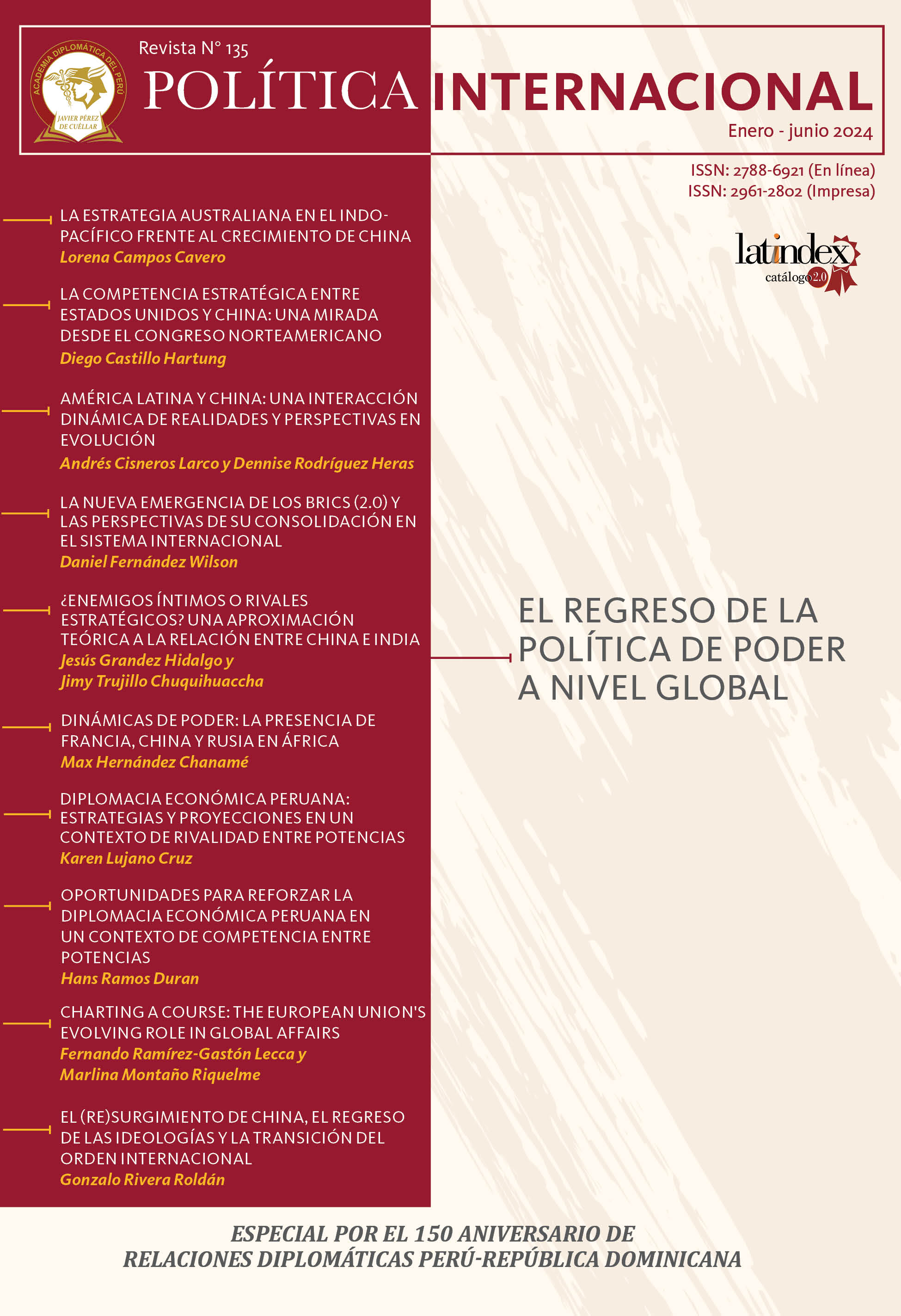Intimate enemies or strategic rivals?: a theoretical approach to the relationship between China and India
DOI:
https://doi.org/10.61249/pi.vi135.150Keywords:
China - India Relationship, Enduring Rivalry, conflict resolution, cooperation and interdependenceAbstract
This article reviews the complex relationship between China and India, marked by both historical tensions and increasing economic cooperation. It aims to understand this hostile intimacy, which challenges conventional explanations from classical theories of International Relations. In this regard, an approach to the theory of 'Enduring Rivalries' is proposed as an alternative framework to understand this prolonged and multifaceted relationship. To this end, the study proposes a development focused on three sections: a historical analysis of bilateral relations, a debate on the relevance of 'Enduring Rivalries,' and an exploration of the relationship's impact on Southeast Asia and beyond. Thus, seeking to provide a perspective that contributes to a better understanding of the challenges and opportunities facing both powers at the regional and global levels.
JAGH: Results Analysis, Discussion, Conclusions, and References.
JTC: Theoretical Framework, Methodology, Discussion, Conclusions, and References.
Downloads
References
Bathiya, R. (2020). Sino-Indian Border Dispute: Explained in Constructivism Paradigm, Institute of Chinese Studies CSI Delhi. https://www.icsin.org/uploads/2020/08/18/29f6638853e327d67e86387502cb9cba.pdf
Egreteau, R. (2012). The China-India Rivalry Reconceptualized, Asian Journal of Political Science, 20(1), 1-22.
Goertz, G. & Diehl, P. F. (1995). The Initiation and Termination of Enduring Rivalries: The Impact of Political Shocks, American Journal of Political Science, 39 (1), 30-52. https://www.jstor.org/stable/2111756?read-now=1&seq=1#page_scan_tab_contents
Geller, D. (1993). Power Differentials and War in Rival Dyads, International Studies Quarterly, 37, 173-194.
Huth, P. & Russett, B. (1993). General Deterrence Between Enduring Rivals: Testing Three Competing Models, American Political Science Review, 87, 61-73.
Pathak, S. P. P. (2009). Reviewed work: Security Perception and China-India relations, Indian Foreign Affairs Journal, 4(3), 126-128. https://www.jstor.org/stable/45340809
Li, L. (2009). Security Perception and China-India Relations. Knowledge World.
Basrur (2011). Book Review: China and India: Great Power Rivals. By Mohan Malik. Contemporary Southeast Asia, 33(3), 388-390. https://www.jstor.org/stable/41446236
Malik, M. J. (2011). China and India: Great Power Rivals. Lynne Rienner.
Jacob, Jabín. T. 2017. 'La Iniciativa de la Franja y la Ruta de China: Perspectivas desde la India', China y la economía mundial, vol. 25, núm. 5, septiembre-octubre, 78-100.
South Asia Subregional Economic Cooperation (SASEC). (s. f.). Recuperado de https://www.sasec.asia/index.php?page=india
Departamento de Asuntos Exteriores y Comercio de Australia (DFAT). (s.f.). Quadrilateral Security Dialogue (Quad). Recuperado de https://www.dfat.gov.au/international-relations/regional-architecture/quad
Wesley Rahn, Murali Krishnan, & Yuchen Li. (2023). POLÍTICACHINA BRICS: ¿podrán China e India superar sus diferencias? Recuperado de https://www.dw.com/es/podrán-china-e-india-superar-sus-diferencias-en-la-cumbre-de-los-brics/a-66616987
Edwin Montesinos, Infobae Perú. (2023). Inversión China en Perú supera los 13 mil millones de dólares y se ha convertido en el principal socio comercial. https://www.infobae.com/peru/2023/10/08/inversion-china-en-peru-cuanto-y-en-que-sectores-invierte-la-nacion-asiatica-en-el-pais/
Cabello, D. (2023). Nuevos horizontes comerciales: el futuro TLC Perú-India. Te lo cuento fácil.
Andina. (2023, 19 de noviembre). Perú espera lograr TLC con India, Hong Kong y Tailandia el 2024. Recuperado de: https://andina.pe/agencia/noticia-peru-espera-lograr-tlc-india-hong-kong-y-tailandia-2024-963473.aspx#
Gartzke, E. & Simon, M. W. (1999). “Hot hand”: a critical analysis of enduring rivalries”, The Journal of Politics, 61(3), 777-798.
Hensel, P. R. (1999). An evolutionary approach to the study of interstate rivalry, Conflict Management and Peace Science, 17(2), 175-206.
Guang, L. (2004). From national identity to national security: China’s changing responses toward India in 1962 and 1998, The Pacific Review, 17(3), 399-422.
Garver, J. W. (2001). Protracted Contest: Sino-Indian Rivalry in the Twentieth Century. Oxford University Press.
Garver, J. W. (2003). Asymmetrical Indian and Chinese threat perceptions’, en S. Ganguly (ed.), India as an Emerging Power. Frank Cass, 109-134.
Shrik, S. L. (2004). One-sided rivalry: China’s perceptions and policies toward India’, en F. Frankel and H. Harding (eds), The India-China Relationship: What the United States Need to Know. Columbia University Press, 75-100.
Frazier, M. W. (2004). Quiet competition and the future of Sino-Indian relations’, en F. Frankel and H. Harding (eds), The India-China Relationship: What the United States Need to Know. Columbia University Press, 294-318.
Deshpande, P. P. (2023, 31 de julio). INDIA China’s Belt & Road initiative with likely implications for India & the world. Truth, Lies and Politics, India, World, TOI. The Times of India. Recuperado de https://timesofindia.indiatimes.com/blogs/truth-lies-and-politics/chinas-belt-road-initiative-with-likely-implications-for-india-the-world/
Downloads
Published
How to Cite
Issue
Section
License
Copyright (c) 2024 Jimy Trujillo, Jesús Grandez Hidalgo

This work is licensed under a Creative Commons Attribution 4.0 International License.








